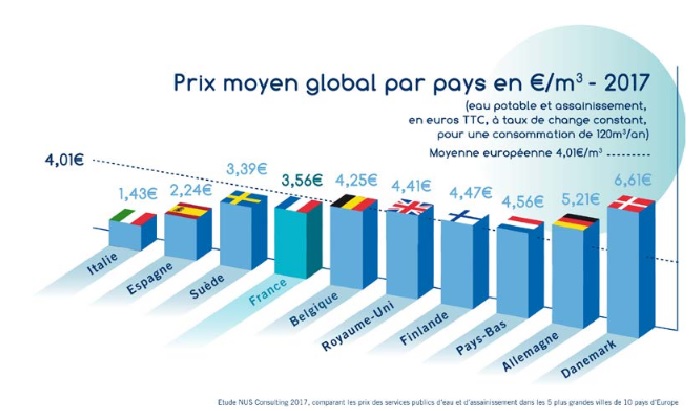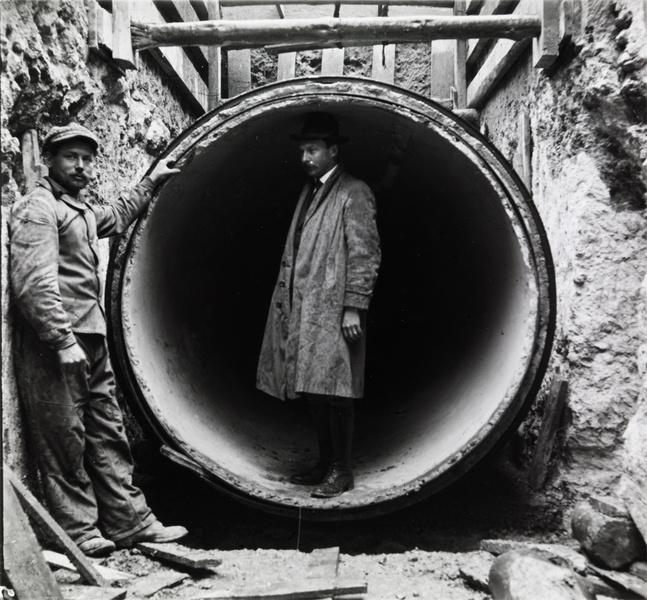And how much are you paying for this water?
At the price of 3,56€/m3, people in France pay less for their water than those living in Denmark, the United Kingdom,Germany, The Netherlands, Finland and Belgium. Here are the figures published in November 2017 by the Fédération professionnelle des entreprises de l’eau/FP2E.

The fact that France’s water prices are 11% lower than the European average (for these 10 European countries) would seem good news for the French consumer. What’s more, figures show the French are paying less on average for water than they used to during the period 2013-2015.
But this drop in price is not good news. Nor is the fact that drinking water in France contributed 14% of the average lead exposure in children aged 13 to 36 months, according to the infant total diet study published in September 2016 by the French Agency for Food, Environmental and Occupational Health & Safety/Anses. (Comparative figures on this with other countries are difficult to come by.)
France under-investing in water pipeline infrastructure
Tristan Mathieu, general delegate for the FP2E, warns against a chronic under-investment in the water sector.
The rate of renewal of the French water supply pipelines is highly inadequate. Bacteria such as legionella, minerals and metals build up in the walls of water pipes, releasing toxins into water. Yet only 0.6% of the ageing network is renewed each year; as the FP2E points out, at that rate it will take 160 years to replace the ageing infrastructure, while the normal length of life of a pipeline is 30 – 80 years. The FP2E recommends doubling the present low rate of renewal.

“The annual renewal investment effort, which is of the order of 800 million euros, should be doubled to around 1.6 billion euros,” says the Fédération professionelle des entreprises de l’eau/FP2E.
The FP2E also draws attention to the fact that there is a big difference between the quality of water distributed in towns and that distributed in rural areas. Bacteriological tests show that the rate of non-conformity in the rural areas is 20 times higher than in urban areas. More requests need to be made for state funding, says Tristan Mathieu, and more joined-up action between local authorities and water agencies.
EU Funds not being claimed
15 billion euros of EU funds are available for water, EU-wide, under the EU European Regional Development Fund and the Cohesion Fund*, for the budget period 2014-2020.
However, European funds for the water sector are not always claimed. Such funds for water policies come within the framework of the EU Directive 2000/60/EC. According to the FP2E, previous structural funds worth one billion euros were attributed for water infrastructure, but not used and subsequently returned to the EU. Just three years into an EU Programme of funding water projects,the FP2E claims that in November 2016 France had used just 4% of those funds, whereas Germany had used 47 per cent (the project stretches over a 7 year period).
International experts agree that the overall quality of drinking water in France is good (although where was the dipstick used to measure it? At the reservoir or out of the tap?) The strength of France’s water policy lies in the fact that France decentralises management while benefitting from government support, the OECD says – an assessment picked up by Tristan Mathieu. France pioneered this approach before it became mandatory in Europe in 2000. At the local level, France has more than 35 000 water and sanitation units. However, agricultural practices, land-use planning and energy production complicates water resource management.
Clear waters turn murky in ageing pipelines
Even if water is declared safe at the water treatment plant, an ageing pipeline distribution infrastructure can render it unsafe to drink. In other words, between the main pipes and the water metre lies the saturnine shadow.

Lead it be
Lead, for example, is still present in many French water pipes both underground and within residential buildings, contaminating the drinking water. To tackle this serious problem Anses calls for action to:
- Speed up the replacement of existing lead pipes.
- Collect more and improved data to determine the levels of lead in the water; and to measure accurately the health impacts of new treatments on levels of lead in the blood stream.
- Find new ways of reducing lead. For example, adding orthophosphate to the water permits the formation of a protective film on the inner walls of pipes. Whereas this method is used in the Ile de France, Anses warns that this treatment does not guarantee compliance with the regulatory quality limit for lead in drinking water at all times and at all points of use.
Orthophosphates: lack of safety statistics
While renewal of the infrastructure continues in France, the 2013 legal norm of lead in pipes (10 µg of lead per litre) is not respected everywhere in the country. Since 2004 Eau de Paris and the Ile-de-France water syndicates have been conducting experiments using orthophosphate (phosphoric acid). Although this has helped lower the level of lead in tap water, Anses warns against possible dangers given the huge lack of statistics on the full impact of this method, something which urgently needs to be addressed: more research is needed to determine the effect on the microbiological quality of the water supply and on the environment.
“Available data do not accurately assess the impact of water treatment with orthophosphate on the quality of the water distributed.” Anses.
Such methods alone will not be enough to bring down levels of lead in France to the accepted norm. So both public services and individual landowners should be sure to replace existing lead pipelines with new non-lead ones, taking advantage of funds available. Meanwhile Anses recommends that if your water has remained in the pipes for a while, e.g. when you get up in the morning, let the tap run a bit before using it for drinking or cooking, and don’t drink or cook with water from the hot tap because water at high temperature increases the dissolution of metal.

_____________________________________
*The Cohesion Fund is specifically targeted for what the Commission refers to as ‘less-developed regions’ to help them catch up with the rest of Europe. France is not eligible for the Cohesion Fund.
See Anses November 2017 report on drinking water in France here.
Consult the FP2E new release here (French only)
Lead Poisoning in children in France, 2008-2011, French Institute for Public Health Surveillance.
Environmental Reviews: France. Highlights 2016.
FOOTNOTES:
– France was recently given formal notice by the European Commission for lack of conformity in 373 urban areas for the treatment of waste water (European Directive 91/271/CEE).
– In his speech November 2017 at a Congress with French Mayors, President Macron announced the creation of an ‘Assises de l’eau’ ( ‘water assizes’, similar to the recent French Estates General for Food) to tackle the water situation in France.
– In Spring 2018 the Filière française de l’eau/FFE will publish a study on the future of water and sanitation from now to 2030, taking into account biotechnologies, big data, the management of micro-pollutants and infrastructure renewal. The study is being piloted by the Pôle interministériel de prospectives et d’anticipation des mutations économiques.
|
|

